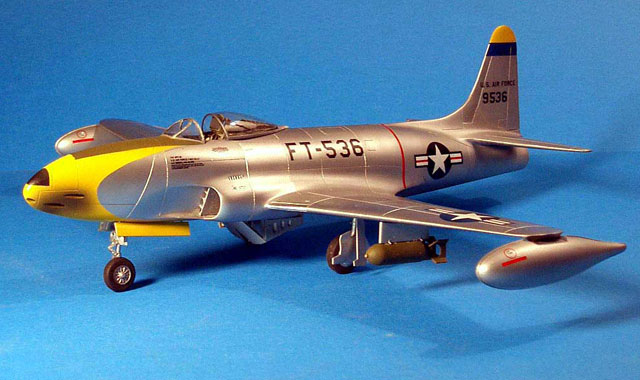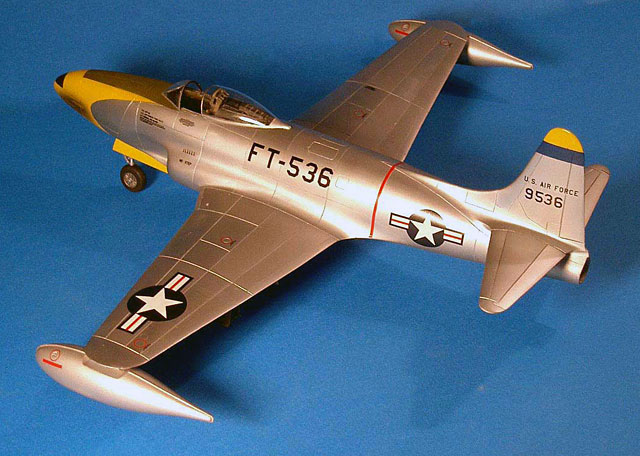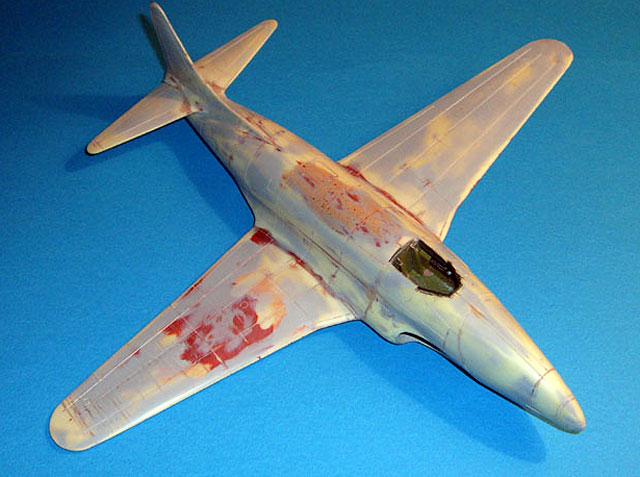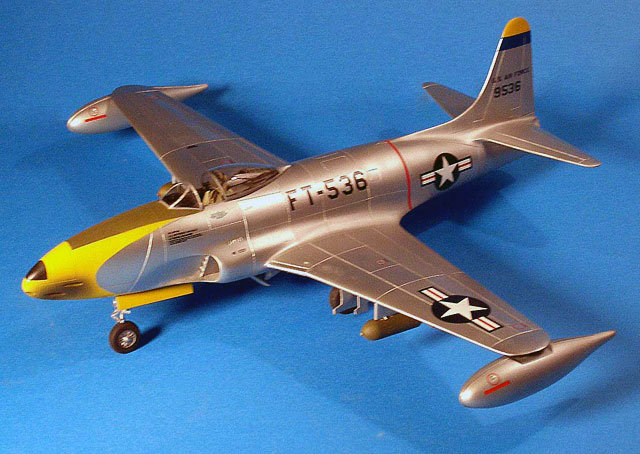|
The Collect-Aire 1/32
scale
F-80 Shooting
Star
by Frank Mitchell
|
 |
|
Lockheed F-80
Shooting Star |

HyperScale is proudly supported by
Squadron
Have you ever built one of those models that just won’t get built,
and which you alternate between wanting to throw it against the wall and
wanting to get it finished just to get the thing out of your life?
Me too, and this is one of them.
As some on Hyperscale will recall, I have not always been a big fan of
this manufacturer, but a couple of years ago, they came out with a T-28
and an F-80 in 32nd, so I decided to give them a shot. The T-28 turned
out to be pretty much unbuildable; lots of problems which are too
numerous to mention here, but if you are curious, email me.

The F-80, on the other hand, looked at first blush to be very nice. The
outlines pretty well seemed to follow the Paul Matt drawings, and there
were some obvious difficulties to overcome. However, since I have built
lots of resin kits, I thought it would be worth the effort.
Overall, the biggest problem is the thickness of the moldings. The
wing, for example, is one solid piece, which is ok, but it does make it
difficult to put the flaps down without a whole lot of scratchbuilding.
In addition, the thickness of the resin in the wing centersection caused
two problems: first, a lot of resin has to be ground away (and some
scratchbuilding added) for the intakes to look like they really lead to
an engine, and second, even more grinding (don’t forget your dust mask)
has to be done before you can correct the dihedral, which is zero on the
model, but very obvious on the real airplane. That is made even more
difficult by the center “keel” between the wheel wells which has to be
split with some kind of saw before that dihedral can be fixed.
My kit also had a warp in the right wing, which is not all that uncommon
in any resin kit, but before I was through, I had to make several
chord-wise cuts in the top surface of the wing and use a fair bit of
Superglue and epoxy to straighten it out.
In compensation for the inability to lower the flaps, the openings for
the air brakes are there and some detail is provided, but the casting
inside those and the wheel wells is quite rough, so detailing requires a
fair amount of work.
The landing gear is all white metal and reasonably well done, just
needing the usual clean-up and painting.

Click on the thumbnails
below to view larger images:
The fuselage construction was a little easier, but the more I fiddled
with it, the more something did not look right. I blew up the Matt plans
to 32nd and discovered the problem: the whole tail section from about an
inch in front of the stabilizer angled upward. I therefore made a saw
cut down from the top of the fuselage almost all the way through and
inserted a wedge that was about 1/8” thick at the top.
All the vents and other openings in the fuselage have to be opened up or
ignored (I did some of both).
Because of the extensive work required, the whole model will have to be
re-scribed which is certainly possible, just a bit more difficult to do
in resin.
Another problem throughout the construction is that while the external
surfaces look fine, as one breaks through the outer surface, lots of
pinholes appear and need to be dealt with.
The decals are numerous and very well done, although the finish is a bit
flat for my taste. There is even a set of Navy markings included, which
is cool.
For me, the main problem was the constant frustration of having to
deal with the basic engineering and molding of the kit. As a result, it
has been in and out of the box about six times over the better part of
two years, and finally was finished only because I was sick of having it
mock me from the shelf.

Resin kits, with notable exceptions, have never been that easy to build,
and I actually think that it is easier to scratchbuild many of the
aircraft. Some folks, however, get wonderful results, so there is
definitely a market and after all, many subjects are available only in
resin.
My only advice would be to make sure you are willing to take on the
work that will be needed, and if possible, look at any resin kit before
you buy to make sure you know what you are getting into.
Model, Images and Text Copyright ©
2006 by Frank Mitchell
Page Created 09 March, 2006
Last Updated
21 February, 2007
Back to
HyperScale Main Page |
Home
| What's New |
Features |
Gallery |
Reviews |
Reference |
Forum |
Search